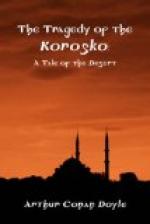And now they were herded in at the base of the Abousir rock, this little group of modern types who had fallen into the rough clutch of the seventh century—for in all save the rifles in their hands there was nothing to distinguish these men from the desert warriors who first carried the crescent flag out of Arabia. The East does not change, and the Dervish raiders were not less brave, less cruel, or less fanatical than their forebears. They stood in a circle, leaning upon their guns and spears, and looking with exultant eyes at the dishevelled group of captives. They were clad in some approach to a uniform, red turbans gathered around the neck as well as the head, so that the fierce face looked out of a scarlet frame; yellow, untanned shoes, and white tunics with square brown patches let into them. All carried rifles, and one had a small discoloured bugle slung over his shoulder. Half of them were negroes—fine, muscular men, with the limbs of a jet Hercules; and the other half were Baggara Arabs—small, brown, and wiry, with little, vicious eyes, and thin, cruel lips. The chief was also a Baggara, but he was a taller man than the others, with a black beard which came down over his chest, and a pair of hard, cold eyes, which gleamed like glass from under his thick, black brows. They were fixed now upon his captives, and his features were grave with thought. Mr. Stuart had been brought down, his hat gone, his face still flushed with anger, and his trousers sticking in one part to his leg. The two surviving Soudanese soldiers, their black faces and blue coats blotched with crimson, stood silently at attention upon one side of this forlorn group of castaways.
The chief stood for some minutes, stroking his black beard, while his fierce eyes glanced from one pale face to another along the miserable line of his captives. In a harsh, imperious voice he said something which brought Mansoor, the dragoman, to the front, with bent back and outstretched supplicating palms. To his employers there had always seemed to be something comic in that flapping skirt and short cover-coat above it; but now, under the glare of the mid-day sun, with those faces gathered round them, it appeared rather to add a grotesque horror to the scene. The dragoman salaamed and salaamed like some ungainly automatic doll, and then, as the chief rasped out a curt word or two, he fell suddenly upon his face, rubbing his forehead into the sand, and flapping upon it with his hands.




